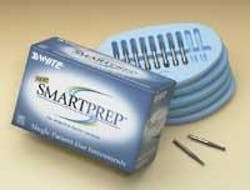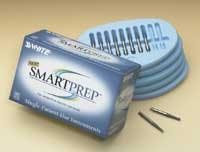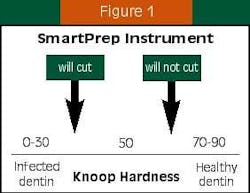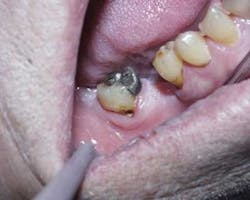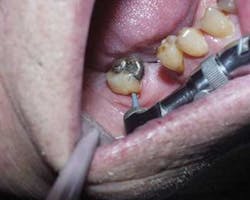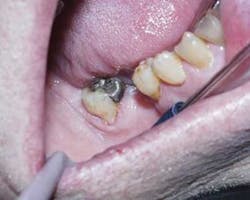SmartPrep™ Today's New Technology: An improved caries-removal system
SmartPrep™ Today's New Technology: An improved caries-removal system
WRITTEN BY
Lori Trost, DMD
Conserving healthy tooth structure is a critical component of today's restorative dentistry. This is especially important due to current adhesion technology linked with compatible cavity preparation design. With traditional detection methods of explorer, magnification, spoon excavator, caries-detection dye, and round burs, active caries can be located, removed, and the tooth restored. However, during this process, the clinician is challenged to discern the precise juncture of the carious dentin from healthy dentin.1 Precision cannot be achieved and questions remain: When is "sound" dentin reached? How does this removal process impact dentin tubules? Has maximum protection of sound tooth structure been achieved?2,3,4
null
One innovative approach to answering these lingering questions about precision caries removal is a new bur system (SS White SmartPrep™ Instrument). Developed to remove decayed dentin without harming healthy tooth structure, combined with a specially designed polymer, this bur system is designed to distinguish healthy dentin from carious dentin based on the hardness of sound dentin. With a Knoop hardness of 50, the system is designed with a reducing cutting capacity when it comes into contact with a surface harder than itself. Tiny polymer flutes in the bur wear away as they contact healthy hard dentin (Figure 1). This self-limiting feature assists in ensuring that diseased dentin will selectively be removed.
In an informal clinical evaluation of 224 cavity preparations utilizing this technology, promising results were found by the evaluating dentists and patients.5 Currently, in-depth clinical trials of the system (SmartPrep Instruments) are being conducted. The bur system functions optimally in a 500 to 800 revolutions per minute (RPM) range, in three sizes (RA #2, RA #4, and RA #6), limited to single patient use. This article presents techniques for utilizing a new system for decay removal for minimally invasive cavity preparation.
null
null
null
null
Case presentation
A 79-year-old male presented with an asymptomatic Class V carious lesion on Tooth No. 31. The following techniques were used:
1. Utilize direct access to the lesion without anesthesia (Figure 2).
2. Select the proper size bur (SmartPrep size RA #4) with a 1:10 torque reduction head to achieve 500 RPMs.
3. Perform traditional preparation for composite. Starting in the center and top of the carious lesion, where the softest and most superficial decay was present, a gentle stroke motion similar to a brush stroke was applied (Figure 3) to each layer of infected dentin. An explorer and caries dye (Caries Finder, Danville) was used to remove the diseased dentin.
4. A bevel of 1 mm was placed on the buccal surface of the cavity and a self-etching primer and bond (Opti-Bond Solo Plus, Kerr) was applied. Using a nano-particled resin (Supreme, 3M/ESPE), a layer technique of body shade A 3.5 and enamel shade A 3 was applied. Each layer was light-cured for 20 seconds (using the Optilux 501) and the final restoration polished with discs (Sof-Lex, 3M/ESPE utilizing a series of four, from coarse to very fine). The patient reported no discomfort during the procedure and was pleased with the aesthetics and comfort of the final restoration (Figure 4) immediately postoperative and three weeks later.
References
1. Fusayama T, Okuse K, Hosoda H. Relationship between hardness, discoloration, and microbial invasion in carious dentin. J Dent Res 1966; 45: 1033-46.
2. Fusayama T. Two layers of carious dentin: diagnosis and treatment. Oper Dent 1979; 4: 63-70.
3. Mount GJ. Preservation and Restoration of Tooth Structure, CV Mosby, London, 1998, 124.
4. Brännström M, Lindén LA, Aström A. The hydro-dynamics of the dental tubule and of pulp fluid. Caries Res 1967;1:310-312.
5. Gallop, Tom. Personal communication, SmartPrep informal evaluation. May 22, 2003.
Lori Trost, DMD Dr. Trost created the Center for Contemporary Dentistry in Columbia, Ill., in 1989. Her practice is known for being in the technological forefront. She is a member of the ADA and AGD and consults for 3M ESPE's "Council for Innovative Dentistry." You can reach Dr. Trost at [email protected].
WDJ's Mission
WDJ seeks to create, strengthen, and support the web of connections for women dentists. Our goals are to provide you with practical tools, to focus on the art and science of dentistry, and to address personal balance. Through our outstanding editorial board, WDJ provides technology transfer on emerging scientific issues, reviews, and resources on practice and team management. Included are critical partnerships for success — with the entire dental team, the laboratory, dental suppliers, and manufacturers.
